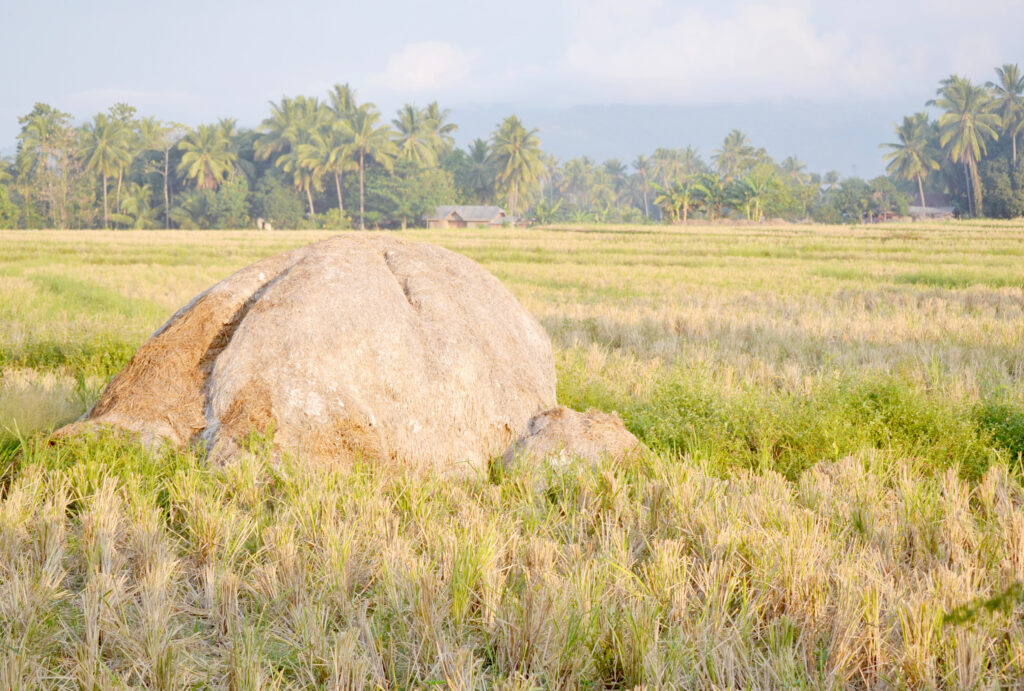For every kilo of rice Filipinos eat, about the same amount of rice straw is produced. The estimated 11.3 million tons of rice straw produced yearly in the country are considered by farmers as waste and disposed of by burning.
“Burning of rice straws, generally practiced during the harvest season, causes air pollutants such as carbon dioxide, carbon monoxide, nitrogen oxide and sulphur dioxide,” according to the Philippine Rice Research Institute.
“Rice straw burning is also known to emit particulate matter and other chemicals such as dioxins and furans that have negative impact on human health,” said a policy brief paper published by the Economy and Environment Program for Southeast Asia.
In addition, some beneficial insects are most likely to be killed when rice straws are burned in the open field.
“Useful insects kill some harmful insects which destroy palay and make production less,” says Evelyn Javier, supervising science research specialist of PhilRice’s Agronomy, Soil and Physiology division.
CO2 is the leading greenhouse gas that changes climate.
Rice’s cultivation, studies have shown, is responsible for nearly half of all carbon emissions from global agriculture. The current methods of rice production emit more CO2 than planes annually: 1,000 metric tons per year compared to 918 MT per year.
Those that are not burned are left to rot in the fields where they emit methane — another GHG which is more than 80 times worse than CO2.
“Methane absorbs heat 21 times more than carbon dioxide and it has 9- to 15-year life time in the atmosphere over a 100-year period,” says Dr. Constancio Asis Jr., a recipient of the 2011 Norman E. Borlaug International Agricultural Science and Technology Fellowship Award.
The Journal Science reported that atmospheric concentration of methane has more than doubled during the last 300 years and is increasing at an annual rate of about 1 percent.
Biogas Hub
Dr. Craig Jamieson, a British national trained in horticulture and holder of a master’s degree in international rural development, has developed bioenergy solutions using rice straws.
In 2016, with support from the United Kingdom government, Jamieson set up his own company, Straw Innovations Ltd., and established a pilot plant that makes clean fuel from rice straw in tandem with the Laguna-based Southeast Asian Regional Center for Graduate Study and Research in Agriculture.
The plant called Rice Straw Biogas Hub aims to make clean energy accessible to remote and underserved rural communities.
“(It) will generate biogas as clean energy from waste rice straw and provide an innovative package of technology services for rice farmers,” says Dr. Glenn B. Gregorio, SEARCA director. The clean fuel is used for drying the grains and milling thereafter.
“We asked farmers and their preference was to use the energy for productive purposes rather than domestic use. So, that’s what we are doing,” according to Jamieson.
Jamieson’s United Kingdom-registered group has established a rice drying service through the combustion of biogas from rice straw.
Drying is the most critical operation after harvesting rice. When rice is harvested, it contains up to 25 percent moisture. The goal of rice drying is to reduce its moisture content to meet the recommended levels for sale and long-term storage.
“It is important to dry rice grain as soon as possible after harvesting —ideally within 24 hours,” IRRI explains. “Delays in drying, incomplete drying or ineffective drying will reduce grain quality and result in losses.”
5-in-1 harvester
But before drying, rice has to be harvested first. Here, the SI is introducing a rice harvesting system that it has developed over five years.
“The main problems are in getting the rice straw out of the field and to a place where it can be used,” he says.
The likely solution: the 5-in-1 harvester.
The first of its kind machine performs five separate operations in one pass of the field namely harvesting, chopping, raking, densifying and collection.
“It’s more efficient and, critically, it works even in wet conditions (muddy or flooded fields),” Jamieson points out.
The collected palay is then brought to another machine where the grain is separated from the rice straw.
“At the biogas hub, a dryer dries the rice grain with energy from the rice wastes, another removes the husk and another mills the grain, thus giving the final product,” Jamieson explains.
The dryer takes about 12 hours to dry grains.
“The technology innovation is to use rice straw to power the process,” he says. “We give farmers the option to retain ownership of their grains throughout the process.”
“In some of today’s cases, farmers only get 4 percent of the purchase price of rice. In our model, farmers can use our harvesting, drying and milling services and then sell the finished products to the public. We just take our cut after the sale.”
